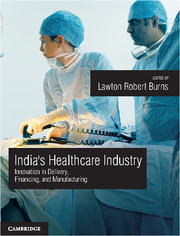Book contents
- Frontmatter
- Contents
- List of Figures
- Preface
- Acknowledgments
- SECTION I Introduction: Lenses and Frameworks for Analyzing India's Healthcare System
- 1 India's Healthcare Industry: A System Perspective
- 2 Innovative Responses to the Healthcare Challenges Confronting India
- 3 India's Healthcare Industry: An Overview of the Value Chain
- SECTION II Providers: Delivery of Healthcare Services
- SECTION III Payers: Financing of Healthcare Services
- SECTION IV Producers: Manufacturers of Healthcare Technology
- Contributors
- Index
3 - India's Healthcare Industry: An Overview of the Value Chain
Published online by Cambridge University Press: 05 June 2014
- Frontmatter
- Contents
- List of Figures
- Preface
- Acknowledgments
- SECTION I Introduction: Lenses and Frameworks for Analyzing India's Healthcare System
- 1 India's Healthcare Industry: A System Perspective
- 2 Innovative Responses to the Healthcare Challenges Confronting India
- 3 India's Healthcare Industry: An Overview of the Value Chain
- SECTION II Providers: Delivery of Healthcare Services
- SECTION III Payers: Financing of Healthcare Services
- SECTION IV Producers: Manufacturers of Healthcare Technology
- Contributors
- Index
Summary
Introduction
This chapter provides a detailed overview of the value chain in India's healthcare system. It covers most of the sectors described in subsequent chapters: physicians (Chapter 4), hospitals (Chapter 5), insurance (Chapter 10), care provided to the bottom of the pyramid (Chapter 11), venture and equity capital financing (Chapter 12), pharmaceuticals (Chapter 13), biotechnology (Chapter 14), medical devices and equipment (Chapter 15), and an overview of healthcare regulation and policy. The chapter is intended as a quick primer on the basics of India's system as well as an introduction to all subsequent chapters; it primarily complements (rather than duplicates) the material found in these chapters.
We begin with a brief description of the administrative structure of India's government and the various roles played by the government in healthcare, and then turn to a lengthy discussion of the evolution of health policy. This provides the necessary context to understand the remainder of the chapter, which provides an in-depth analysis of the payers, providers, and producers.
Public administration and policy
Central versus state government responsibilities
India's Constitution assigns the central government primary responsibility for defense, the armed forces, foreign trade, banking, income tax, etc. (the Central List). It assigns the states co-responsibility (with the central government) for providing economic and social planning, education, welfare, and labor (the Concurrent List). The Constitution assigns the states the primary responsibility for providing public order, social services, land policies, electricity, etc. (the State List).
- Type
- Chapter
- Information
- India's Healthcare IndustryInnovation in Delivery, Financing, and Manufacturing, pp. 59 - 138Publisher: Cambridge University PressPrint publication year: 2014
- 1
- Cited by



